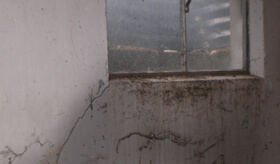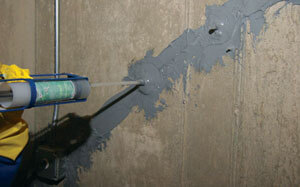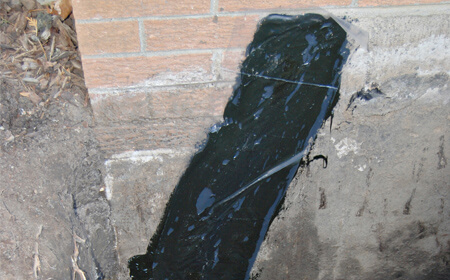Foundation wall cracks
Cracks in a foundation wall may be caused from the normal shrinking and curing process of concrete. However, sometimes, the cracks could be a warning sign that the foundation itself is experiencing serious problems, such as settlement, or it could have issues with excessive hydrostatic pressure in the earth which can cause walls to lean into the basement of a home.
The cracks may start at the top of the foundation, or they could also appear in the middle or at the bottom of a wall. They may grow in horizontal, stair-step, or vertical patterns. The cracks may also be very narrow, or they could have a very thick opening of a 1/2" or greater. The cracks can devalue a property quite significantly, and eventually they may even let water seep into the home.
Water always finds the path of least resistance, and if there are cracks in the foundation wall, water will eventually make its way inside via these outlets. It may start off as just a trickle of moisture at first, but over time with erosion and excessive damage to the wall, water will start to seep into the home in very large quantities.

Warnings Signs of a Leaky Wall Crack
Most homeowners will know that they have this problem if they see the following in the basements of their homes:
- Water can be physically seen dripping down from a crack.
- Stains or obvious signs of water damage are seem on the walls.
- Puddles of water appear on the floor below the crack.
- Mold starts growing on the wall under or around the crack itself.
- The crack appears to be getting bigger and bigger in depth and size.
Evaluating Wall Cracks
Below are some helpful tips when it comes to inspecting and evaluating the cracks in your foundation:
- Look at the shape, pattern, and frequency of the wall cracks. Make note of the length, size, angles, and placement of walls next to the crack.
- Shrinkage cracks. These typically are uniform in size and width. They are wider at the top and smaller at the bottom. If the crack extends into the floor may indicate a problem with the footings of the home.
- Concrete shrinks as it dries and hardens. These types of cracks are not always uniform and shape and size. They could be hairline cracks, discontinuous cracks, or there may be multiple cracks in one section of the wall.
- Poured concrete shrinkage cracks. They are usually caused from poor construction techniques or materials. They typically do not pose a problem for the structural integrity of a home.
- Concrete block foundation walls shrink while they cure. These types of cracks rarely get bigger when exposed to moisture. The openings are also usually uniform in shape and size, and they occur towards the center of the wall.
- Brick walls usually don't shrink. These cracks are often caused from movement in the structure or from thermal expansion.
- Stone foundation walls usually will have cracks in just one stone. However, you may also notice bulging or bowing of the effected stone.
Moisture in the Basement
When water gets into the home, it can lay stagnant for days on end. This is especially true if the basement is not finished and if the homeowner doesn't spend much time in this area of their home. They may be unaware that there is even a problem.
Once water gets inside, it will drip down the walls, causing damage to whatever type of wall coverings are in place. The moisture will eventually reach the floor where it may lay in puddles. All of this water can cause serious problems inside of the basement environment, and these are problems which will eventually effect other areas of the home.
Water here can be very damaging to wooden materials. This includes support beams and floor joists which are partially responsible for holding up the weight of the home. The moisture will cause them to warp, rot, decay, and bend. Eventually, if the problem goes untreated for too long, it can actually jeopardize the structural integrity of the entire home. This rotting wood can also be very attractive to unwanted critters, including termites and roaches.
Furthermore, the moisture will eventually trigger the growth of dangerous mold and bacteria below the home. Mold needs three things to live, including moisture, humidity, and organic materials to feed off of. Mold is often dark green or black in color, and it can be seen growing on floors, walls, ceilings, boxes, and so on. When it grows, it releases spores into the air.
When the spores are breathed in, it can cause a variety of health problems, including: asthma attacks, coughing, sneezing, headaches, fatigue, skin rashes, allergies, irritation, and many other serious medical problems.

Fixing Wall Cracks
There are several solutions when it comes to fixing wall cracks inside and outside of a home. Professionals will be able to provide you with interior or exterior crack repair.
Interior Crack RepairFixing a crack from inside of the home will first involve cleaning off the surface of the wall. This helps to ensure that no debris gets inside the opening during the repair process. Next, the crack will be filled using either an epoxy or urethane injection material. This helps to seal the opening off so that moisture isn't able to get inside. The materials typically will cure and harden with a few days.

This will involve digging out the soil from around the area in the foundation where the crack exists. The crack will be chipped at until it is large enough to be filled with a special epoxy or polyurethane injection. The crack is filled and sealed. Next, an exterior waterproofing membrane may be installed over the wall to prevent water from pushing up against this weakened area in the foundation.
